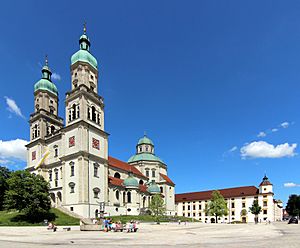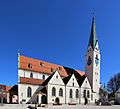Kempten facts for kids
Quick facts for kids
Kempten
|
|||
|---|---|---|---|

Church St. Lorenz Basilica
|
|||
|
|||
| Country | Germany | ||
| State | Bavaria | ||
| Admin. region | Swabia | ||
| District | Urban district | ||
| Elevation | 674 m (2,211 ft) | ||
| Population
(2022-12-31)
|
|||
| • Total | 70,056 | ||
| Time zone | CET/CEST (UTC+1/+2) | ||
| Postal codes |
87401–87439
|
||
| Dialling codes | 0831 | ||
| Vehicle registration | KE | ||
| Website | www.kempten.de | ||
Kempten is the biggest town in the Allgäu region, located in Swabia, Bavaria, Germany. About 68,000 people lived there in 2016. Kempten is known as the oldest town in Germany. It might have been first settled by the Celts. Later, the Romans took over and named it Cambodunum.
History of Kempten
Early Times: Celts and Romans
A Greek writer named Strabo mentioned a Celtic town called Kambodunon around 50 BC. This is the oldest written record of any German city. However, archaeologists have not yet found proof that this Celtic town really existed.
Around 15 BC, Roman soldiers led by Nero Claudius Drusus and Tiberius conquered the area. They destroyed a Celtic settlement there. The Romans then built their own town called Cambodunum.
This Roman town was built with a typical Roman plan. It had baths, a public square (forum), and temples. At first, the buildings were made of wood. But after a big fire in 69 AD, the town was rebuilt using stone. Cambodunum might have been the capital of the Roman area called Raetia for a while. Later, Augsburg became the capital instead. Many old building foundations have been found through archaeological digs in Kempten.
In 233 AD, a Germanic tribe called the Alemanni destroyed the city. After this, the people moved the settlement to a safer spot. This new place was on a hill called Burghalde, overlooking the Iller river. By the mid-5th century, the last Roman soldiers left the area. The Alemanni then fully took over the city.
Middle Ages: Monks and Two Cities
After the Romans left, the town moved from the hill back down to the flat land near the Iller river. It was known as Cambidano. In 683, the town was destroyed again by the Franks. This happened because the town supported a rebellion against the Frankish kingdom.
Around 700 AD, a monastery was built in Kempten. It was the first one in the Allgäu region. Two monks from the Abbey of Saint Gall started it. The monastery became very important and powerful. This was thanks to the support of Charlemagne’s wife, Hildegard, who was an Alemannic princess.
After being attacked by the Magyars several times, the monastery and city were rebuilt starting in 941. This was led by Ulrich of Augsburg, who was a bishop and also the abbot of Kempten.
In 1213, the Holy Roman Emperor Frederick II gave the abbots of Kempten a special title: Duke. This meant they had a lot of power. However, in 1289, King Rudolf I also gave special rights to the town itself. This made Kempten a Free Imperial City. This meant the town was independent from the monastery.
By 1525, the monastery sold its last properties in the Imperial City. This led to two independent cities existing side-by-side, both named Kempten. More problems arose in 1527 when the Imperial City became Protestant. This was against the Catholic monastery.
Later Years: Wars and Unity
During the Thirty Years' War (1632–33), both the monastery's city and the Imperial City were destroyed. One by imperial forces, the other by Swedish troops.
In 1652, the Abbot of Kempten, Roman Giel of Gielsberg, ordered a new church to be built. This church, St. Lorenz Basilica, was also a home for the Duke-Abbots. It was one of the first large churches built in Germany after the war.
During the Napoleonic Wars (1802–03), both the monastery's area and the Imperial City came under Bavarian rule. Finally, in 1819, the two rival cities joined together to become one single city.
During World War II, Kempten was affected, like many cities in Germany.
A famous person from Kempten was Claude Dornier (1884–1969). He was a German engineer who designed airplanes. He founded Dornier GmbH. Some planes named after him include the Dornier Do 18 and the huge 12-engine Dornier Do X flying boat.
Climate in Kempten
Kempten has a moderate climate. The average temperature for the year is about 8.2 degrees Celsius. The city gets a lot of rain, especially in summer. It also gets snow in winter.
| Climate data for Kempten (1991–2020 normals) | |||||||||||||
|---|---|---|---|---|---|---|---|---|---|---|---|---|---|
| Month | Jan | Feb | Mar | Apr | May | Jun | Jul | Aug | Sep | Oct | Nov | Dec | Year |
| Mean daily maximum °C (°F) | 3.5 (38.3) |
4.9 (40.8) |
9.2 (48.6) |
13.7 (56.7) |
17.9 (64.2) |
21.5 (70.7) |
23.2 (73.8) |
23.1 (73.6) |
18.4 (65.1) |
14.0 (57.2) |
8.0 (46.4) |
4.2 (39.6) |
13.5 (56.3) |
| Daily mean °C (°F) | −0.8 (30.6) |
−0.1 (31.8) |
3.7 (38.7) |
7.7 (45.9) |
12.1 (53.8) |
15.8 (60.4) |
17.3 (63.1) |
17.0 (62.6) |
12.7 (54.9) |
8.6 (47.5) |
3.3 (37.9) |
0.1 (32.2) |
8.2 (46.8) |
| Mean daily minimum °C (°F) | −4.6 (23.7) |
−4.5 (23.9) |
−1.0 (30.2) |
2.0 (35.6) |
6.4 (43.5) |
10.3 (50.5) |
12.0 (53.6) |
11.7 (53.1) |
8.0 (46.4) |
4.3 (39.7) |
−0.5 (31.1) |
−3.6 (25.5) |
3.4 (38.1) |
| Average precipitation mm (inches) | 80.7 (3.18) |
73.0 (2.87) |
86.3 (3.40) |
74.3 (2.93) |
124.1 (4.89) |
143.1 (5.63) |
141.5 (5.57) |
147.3 (5.80) |
100.4 (3.95) |
81.3 (3.20) |
82.0 (3.23) |
90.0 (3.54) |
1,222.8 (48.14) |
| Average precipitation days (≥ 1.0 mm) | 15.7 | 14.7 | 16.0 | 14.8 | 17.2 | 17.7 | 16.6 | 15.7 | 14.9 | 14.4 | 14.8 | 17.1 | 189.1 |
| Average snowy days (≥ 1.0 cm) | 17.8 | 17.6 | 9.5 | 2.4 | 0 | 0 | 0 | 0 | 0.1 | 0.6 | 6.4 | 14.4 | 68.8 |
| Average relative humidity (%) | 83.2 | 80.0 | 76.3 | 73.2 | 74.5 | 74.3 | 74.5 | 77.1 | 82.1 | 84.2 | 86.1 | 85.1 | 79.2 |
| Mean monthly sunshine hours | 84.2 | 102.4 | 145.7 | 173.5 | 189.0 | 204.0 | 225.0 | 215.5 | 162.6 | 123.5 | 85.0 | 75.7 | 1,802.4 |
| Source: World Meteorological Organization | |||||||||||||
Main Sights to See
Kempten has many interesting places to visit.
- The beautiful St. Lorenz Basilica is a must-see church.
- The St. Mang Church is another historic church.
- The Burghalde is an old ruin with a great view.
- You can visit the Duke-Abbots' Residence, where the old leaders lived.
- Explore the Archaeological Park Cambodunum to see Roman ruins.
- The City Hall and its square are a central part of town life.
- The Erasmuskapelle is a unique underground chapel.
Getting Around Kempten
Kempten has good transport connections.
- The A 7 highway connects Kempten to cities like Würzburg and Ulm.
- Other main roads like the B 12, B 19, and B 309 also meet here.
- The city has a train station, Kempten station. It offers good train services, including InterCity and EuroCity trains.
- Kempten also has a city bus system with over 20 lines.
Education in Kempten
Kempten is a place for learning!
- The Kempten University of Applied Sciences opened in 1978. It started with 89 students and now has over 2,800 students. They can study many subjects, including:
- Business Administration
- Computer Science
- Electrical Engineering
- Industrial Engineering
- Mechanical Engineering
- Social Management
- Tourism and Hospitality Management
- There are also three high schools called Gymnasium. These schools offer secondary education to students from all over the Allgäu region.
Sports and Fun
Kempten offers different sports activities.
- The local association football (soccer) team, FC Kempten, plays at the Illerstadion. This stadium is also used for athletics.
- An American football team, the Allgäu Comets, also uses the stadium.
- The motor racing team Abt Sportsline is based in Kempten.
Famous People from Kempten
Many notable people were born or lived in Kempten:
- Carl von Linde (1842–1934), a scientist who invented cooling technology.
- Claude Dornier (1884–1969), a famous aircraft designer.
- Ernst Mayr (1904–2005), a German-American biologist.
- Ignaz Kiechle (1930–2003), a politician who served in the German parliament.
- Heide Schmidt (born 1948), an Austrian politician.
- Günther Dollinger (born 1960), a physicist and professor.
- Franz Engstler (born 1961), a racing car driver.
- Dieter Lohr (born 1965), a writer.
- Christian Abt (born 1967), a racing car driver.
- İlhan Mansız (born 1975), a Turkish football player.
- Peter Terting (born 1984), a racing car driver.
- Lisa Brennauer (born 1988), a world champion cyclist.
- Daniel Abt (born 1992), a racing car driver.
- Friedrich Ferdinand Schnitzer, a well-known American architect.
Sister Cities
Kempten has special partnerships with other cities around the world. These are called sister cities:
 Bad Dürkheim, Germany (since 2001)
Bad Dürkheim, Germany (since 2001) Quiberon, France (since 1971)
Quiberon, France (since 1971) Sligo, Ireland (since 1990)
Sligo, Ireland (since 1990) Sopron, Hungary (since 1987)
Sopron, Hungary (since 1987) Trento, Italy (since 1987)
Trento, Italy (since 1987)
Images for kids
See also
 In Spanish: Kempten para niños
In Spanish: Kempten para niños







